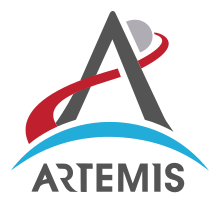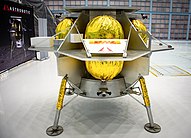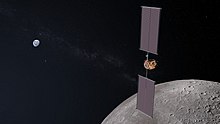
A lunar lander or Moon lander is a spacecraft designed to land on the surface of the Moon. As of 2024, the Apollo Lunar Module is the only lunar lander to have ever been used in human spaceflight, completing six lunar landings from 1969 to 1972 during the United States' Apollo Program. Several robotic landers have reached the surface, and some have returned samples to Earth.

Astrobotic Technology inc., commonly referred to as Astrobotic is an American private company that is developing space robotics technology for lunar and planetary missions. It was founded in 2007 by Carnegie Mellon professor Red Whittaker and his associates with the goal of winning the Google Lunar X Prize. The company is based in Pittsburgh, Pennsylvania. Their first launch occurred on January 8, 2024, as part of NASA's Commercial Lunar Payload Services (CLPS) program. The launch carried the company's Peregrine lunar lander on board the first flight of the Vulcan Centaur rocket from Florida's Space Force Station LC-41. The mission was unable to reach the Moon for a soft or hard landing. On June 11, 2020, Astrobotic received a second contract for the CLPS program. NASA will pay Astrobotic US$199.5 million to take the VIPER rover to the Moon, targeting a landing in November 2024.

Artemis 1, officially Artemis I and formerly Exploration Mission-1 (EM-1), was an uncrewed Moon-orbiting mission. As the first major spaceflight of NASA's Artemis program, Artemis 1 marked the agency's return to lunar exploration after the conclusion of the Apollo program five decades earlier. It was the first integrated flight test of the Orion spacecraft and Space Launch System (SLS) rocket, and its main objective was to test the Orion spacecraft, especially its heat shield, in preparation for subsequent Artemis missions. These missions seek to reestablish a human presence on the Moon and demonstrate technologies and business approaches needed for future scientific studies, including exploration of Mars.
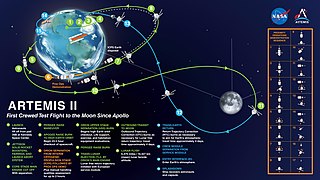
Artemis 2 is a scheduled mission of the NASA-led Artemis program. It will use the second launch of the Space Launch System (SLS) and include the first crewed mission of the Orion spacecraft. The mission is scheduled for no earlier than September 2025. Four astronauts will perform a flyby of the Moon and return to Earth, becoming the first crew to travel beyond low Earth orbit since Apollo 17 in 1972. Artemis 2 will be the first crewed launch from Launch Complex 39B of the Kennedy Space Center since STS-116 in 2006.

Artemis 3 is planned to be the first crewed Moon landing mission of the Artemis program and the first crewed flight of the Starship HLS lander. Artemis 3 is planned to be the second crewed Artemis mission and the first American crewed lunar landing since Apollo 17 in December 1972. In December 2023, the Government Accountability Office reported that the mission is not likely to occur before 2027; as of January 2024, NASA officially expects Artemis 3 to launch no earlier than September 2026 due to issues with the valves in Orion's life support system.
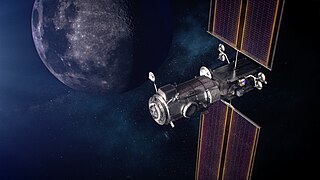
The Lunar Gateway, or simply Gateway, is a space station which Artemis program participants plan to assemble in an orbit near the Moon. The Gateway is intended to serve as a communication hub, science laboratory, and habitation module for astronauts. It is a multinational collaborative project: participants include NASA, the European Space Agency (ESA), the Japan Aerospace Exploration Agency (JAXA), the Canadian Space Agency (CSA) and the Mohammed Bin Rashid Space Centre (MBRSC). The Gateway is planned to be the first space station beyond low Earth orbit.

Blue Moon is a family of lunar landers and their associated infrastructure, intended to carry humans and cargo to the Moon, currently under development by a consortium led by Blue Origin and including Lockheed Martin, Draper, Boeing, Astrobotic, and Honeybee Robotics. Two versions of Blue Moon are under development: a robotic lander planned to land on the Moon in 2024, and a larger human lander planned to land a crew of four astronauts on the lunar surface for the NASA Artemis V mission in 2029.

The year 2022 witnessed the number of launches of SpaceX's Falcon rocket family surpassing the CNSA's Long March rocket family, making the United States the country with the highest number of launches in 2022 instead of China. This year also featured the first successful launch of Long March 6A, Nuri, Angara 1.2, Vega-C, Kinetica-1, and Jielong-3. National space agencies' activities in this year is also marred by the Russian invasion of Ukraine, leading to tension between Roscosmos and Western space agencies, threats of ending collaboration on the International Space Station (ISS), and delays on space missions.

Commercial Lunar Payload Services (CLPS) is a NASA program to hire companies to send small robotic landers and rovers to the Moon. Most landing sites are near the lunar south pole where they will scout for lunar resources, test in situ resource utilization (ISRU) concepts, and perform lunar science to support the Artemis lunar program. CLPS is intended to buy end-to-end payload services between Earth and the lunar surface using fixed-price contracts. The program was extended to add support for large payloads starting after 2025.
ispace Inc. is a public Japanese company developing robotic spacecraft and other technology to compete for both transportation and exploration mission contracts from space agencies and other private industries. ispace's mission is to enable its clients to discover, map, and use natural lunar resources.

The Intuitive Machines Nova-C, or simply Nova-C, is a class of lunar landers designed by Intuitive Machines (IM) to deliver small payloads to the surface of the Moon. Intuitive Machines was one of three service providers awarded task orders in 2019 for delivery of NASA science payloads to the Moon. The IM-1 lunar lander, named Odysseus, was launched by a SpaceX Falcon 9 rocket on 15 February 2024, reached lunar orbit on 21 February, and landed on the lunar surface on 22 February. This marked the inaugural Nova-C landing on the Moon and the first American spacecraft to perform a soft landing on the Moon in over 50 years. It is the first spacecraft to use methalox propulsion to navigate between the Earth and the Moon.

Intuitive Machines, Inc. is an American space exploration company headquartered in Houston, Texas. It was founded in 2013 by Stephen Altemus, Kam Ghaffarian, and Tim Crain, to provide lunar surface access, lunar orbit delivery, and communication from lunar distance. Intuitive Machines holds three NASA contracts under the space agency's Commercial Lunar Payload Services (CLPS) initiative, to deliver payloads to the lunar surface.Among these, the company holds a contract to develop a Lunar Terrain Vehicle (LTV).

The Artemis program is a Moon exploration program that is led by the United States' NASA and was formally established in 2017 via Space Policy Directive 1. The Artemis program is intended to reestablish a human presence on the Moon for the first time since Apollo 17 in 1972. The program's stated long-term goal is to establish a permanent base on the Moon to facilitate human missions to Mars.

Artemis 4 is a planned mission of the NASA-led Artemis program. The mission will include the fourth use of a Space Launch System (SLS) launch vehicle, will send an Orion spacecraft with four astronauts to the Lunar Gateway space station, install a new module on the Gateway, and conduct the second lunar landing of the Artemis program.

Artemis 5 is the fifth planned mission of NASA's Artemis program and the first crewed flight of the Blue Moon lander. The mission will launch four astronauts on a Space Launch System rocket and an Orion to the Lunar Gateway and will be the third lunar landing of the Artemis program. In addition, Artemis V will also deliver two new elements to the Gateway Space Station.

CAPSTONE is a lunar orbiter that is testing and verifying the calculated orbital stability planned for the Lunar Gateway space station. The spacecraft is a 12-unit CubeSat that is also testing a navigation system that is measuring its position relative to NASA's Lunar Reconnaissance Orbiter (LRO) without relying on ground stations. It was launched on 28 June 2022, arrived in lunar orbit on 14 November 2022, and was scheduled to orbit for six months. On 18 May 2023, it completed its primary mission to orbit in the near-rectilinear halo orbit for six months, but will stay on this orbit, continuing to perform experiments during an enhanced mission phase.

Starship HLS is a lunar lander variant of the Starship spacecraft that is slated to transfer astronauts from a lunar orbit to the surface of the Moon and back. It is being designed and built by SpaceX under the Human Landing System contract to NASA as a critical element of NASA's Artemis program to land a crew on the Moon.

The International Habitation Module, International Habitat or I-HAB is designed as a habitat module of the Lunar Gateway station, to be built by the European Space Agency (ESA) in collaboration with the Japan Aerospace Exploration Agency, or JAXA. The I-HAB will have a maximum launch mass of 10,000 kg (22,000 lb) and provide a habitable volume of 10 m3 (350 cu ft).
